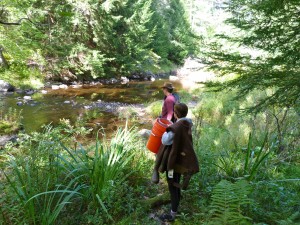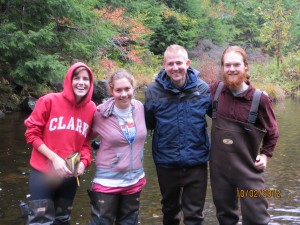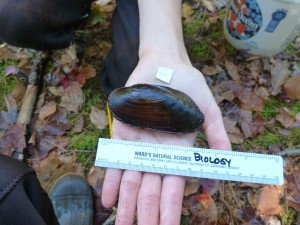Mussel Madness!

My first introduction to Margaritifera margaritifera, the freshwater pearl mussel, occurred during a stream site visit in the Spring of 2010. Brittany Laginhas (’10), a senior at the time, planned to conduct Masters research on the population distribution and habitat requirements of the freshwater pearl mussel in Massachusetts under the supervision of Professor John Baker. I was brought along that day as an extra set of eyes to help initially explore the stream system and look for the mussel.
Student interest in the freshwater pearl mussel and stream systems has grown in the Foster/Baker laboratory since Brittany completed her Masters. I myself became intrigued with the life cycle of the mussel, a topic that invites many questions in Massachusetts streams. After the female’s eggs are fertilized, the early embryos must leave the female and attach to an appropriate host fish, creating a host-parasite relationship between the mussel and a fish. The host fish are typically salmonids, such as trout or salmon; however, this host-parasite relationship has predominantly been studied in Europe where the species is critically threatened due to overfishing and anthropogenic alterations to stream ecosystems. In Massachusetts streams though, salmonids are rare, yet the mussel is common— begging the question I plan to research during my Master’s thesis— is the freshwater mussel using an alternative host fish?

As Nick Pagan (’15), Hannah Reich (’15) and I began scouring the literature for information on the freshwater pearl mussel, one scientist’s name seemed to continuously appear – Dr. Prof. Jürgen Geist. Professor Geist, from the Technische Universität München in Germany, is a leader in the study of the ecology, genetics and conservation of the M. margaritifera throughout Europe. Through a mixture of luck and coordination, Clark University’s biology department hosted Professor Geist in the Fall of 2012 for four days. During his visit, Professor Geist presented multiple lectures concerning the freshwater pearl mussel and conservation efforts in Europe. He also traveled to Massachusetts stream sites with Nick, Hannah, Professor Baker and me, showing us how to easily find and identify the mussel. He also showed us how to tell if a mussel is gravid (has eggs). Finally, Professor Geist helped me establish a methodology for my Master’s thesis, including the process of tissue removal for DNA analysis.

Since Professor Geist’s visit we have collected around 50 tissue samples for DNA analysis and conducted multiple stream site visits. Also, on June 14th I am flying to Germany to work in Professor Geist’s laboratory and learn mussel DNA sequencing techniques thanks to funding from the Geller Student Research Awards! In the mean time research continues on mussels in our local streams (go Nick and Hannah!).